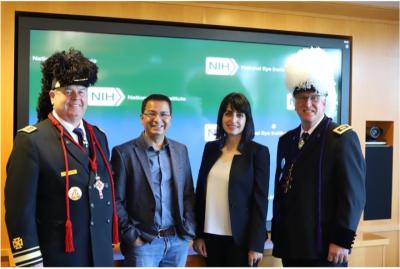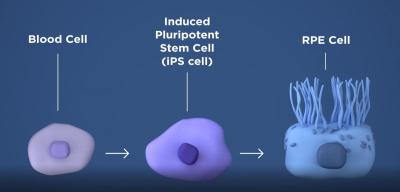
From left to right: John H. Austin, Grand Commander of Maryland, KTEF; Kapil Bharti, Ph.D., senior investigator in the Ocular and Stem Cell Translational Research Section at NEI; Mitra Farnoodian Tedrick, Ph.D., recipient of the KTEF grant, NEI; James B. Steele, Mid-Atlantic Department Commander, KTEF. Credit: NEI
NEI researcher Mitra Farnoodian Tedrick, Ph.D., received a $65,000 grant from the Knights Templar Eye Foundation (KTEF) to identify drugs to treat a rare blinding condition called Stargardt disease.
Stargardt, caused by mutations in a gene called ABCA4, affects 1 in 10,000 people in the US. No therapies exist for the disorder, characterized by lipid deposits called lipofuscin in the retinal pigment epithelium (RPE).
The RPE is a layer of tissue that nourishes and supports the retina’s light-sensing photoreceptors. Accumulation of lipofuscin causes photoreceptors to die, leading to blindness. Childhood-onset Stargardt is often associated with severe visual loss.
“Funds generously provided by the Knights Templar will help Dr. Tedrick discover drugs that might slow Stargardt disease by modifying lipid metabolism in the RPE,” said Kapil Bharti, Ph.D., who leads the NEI Ocular and Stem Cell Translational Research Section, where Dr. Farnoodian Tedrick does her research.

Researchers take blood cells, and in a lab, convert them into iPS cells capable of becoming almost any type of cell in the body. In this case, the iPS cells are programmed to mimic lipid deposition and RPE atrophy, typical of Stargardt disease. Credit: NEI
Central to their drug screening effort is a patient stem cell-derived RPE model that mimics lipid deposition and progressive RPE atrophy seen in Stargardt patient’s eyes. The model will enable high-throughput drug screening and subsequent testing of drug candidates on various Stargardt subtypes. Scientists have identified more than ABCA4 mutations.
“I am honored to have received this grant,” said Dr. Tedrick. “NEI’s Intramural Research Program has provided me with the tools to first develop this project, and with the KTEF grant I hope my research encourages others to find therapies for rare diseases like Stargardt, which may, one day, eliminate blindness in children and young adults.”

Dr. Farnoodian Tedrick explains her research project to the Knights Templar commanders. Credit: NEI
The Knights Templar Eye Foundation is a charity sponsored by the Grand Encampment of the Knights Templar, which supports pediatric ophthalmology research. Their career-starter grants are awarded to early-career researchers studying vision problems in children. This is the third such grant awarded to an NEI researcher in the past three years.
“I have been in Templary Masonry for the last 22 years which includes multiple fundraisers for the Knights Templar Eye Foundation. I am very pleased to be able to see first-hand the good work grant recipients do with the hard-earned money we raise,” said James B. Steele, Mid-Atlantic Department Commander, KTEF.